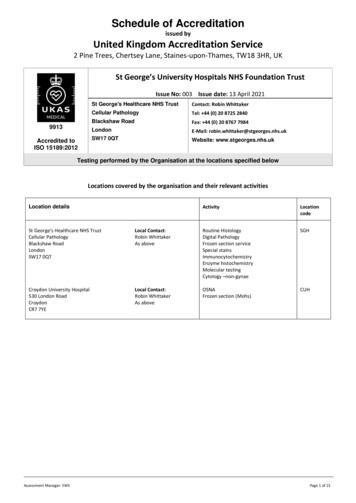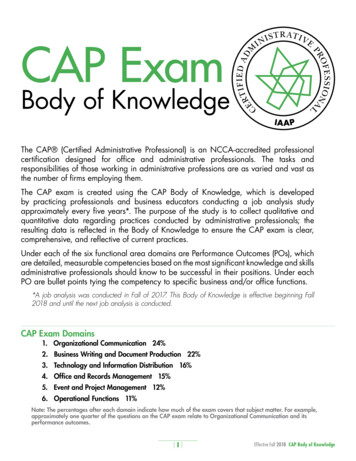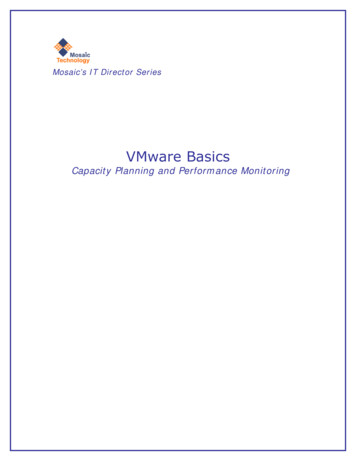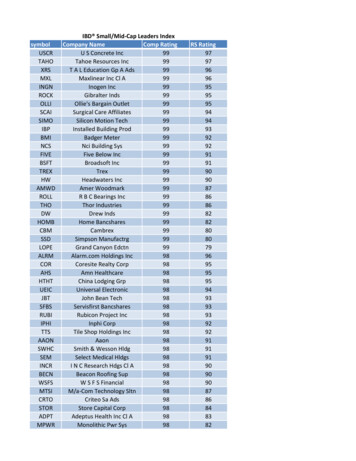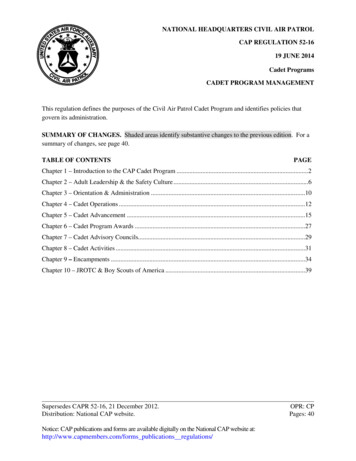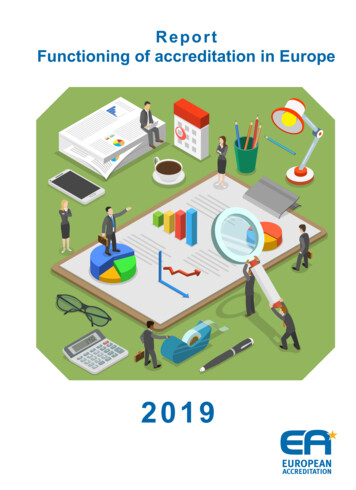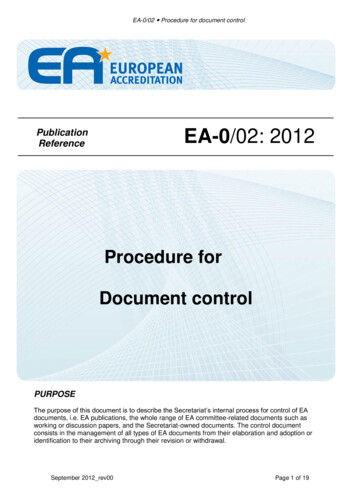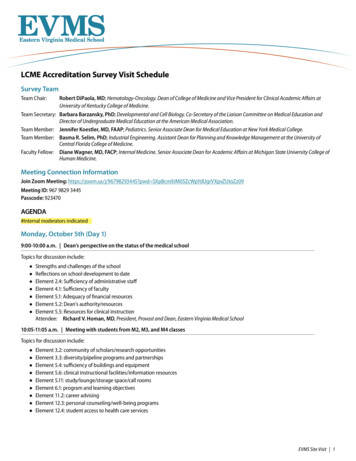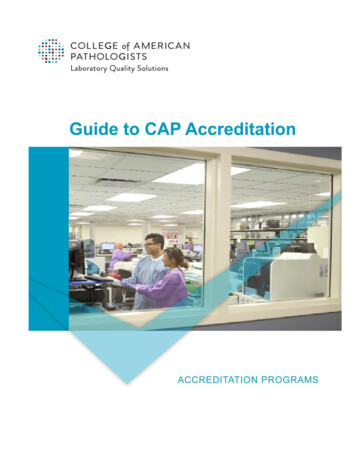
Transcription
cap.org325 Waukegan Rd. Northfield, IL 60093t: 800-323-4040 cap.orgVersion no.12.05.2018
Guide to CAP AccreditationTable of ContentsLaboratory Accreditation and the College of American Pathologists2Things to Know for CAP Laboratory Accreditation5Application Process7Director Responsibilities8Document Control System11Chemical Hygiene Plan12Laboratory Information Systems13Test Menu Validation15Competency Assessment Program16Quality Management Program17 2019 College of American Pathologists. All rights reserved.PAGE 2Jan2019
Guide to CAP AccreditationLABORATORY ACCREDITATION AND THE COLLEGE OF AMERICAN PATHOLOGISTSAbout the CAPLaboratoryAccreditationProgramThe CAP’s internationally recognized accreditation programs offer the mostrespected choice to achieve accreditation and maintain regulatory compliance .The programs are built on a unique, reciprocal, peer-based inspection methodthat benefits both the laboratories being inspected and the laboratories providingthe inspection teams.The accreditation programs guide laboratories to achieve the highest standard ofexcellence in patient care.The requirements for accreditation are based on more than fifty years of insightand pathology expertise. The requirements comprise documents known asChecklists and are updated annually to reflect current practices andtechnologies. The Checklists are used by the laboratory to prepare forinspections and by the inspection team as a guide to assess the overall quality ofthe laboratory and the compliance with CAP Checklist requirements.What to expect byparticipating in theCAP LaboratoryAccreditationProgram?An on-site laboratory inspection occurs every two years. In the years when anon-site inspection does not occur, the laboratory performs a self-inspection usingmaterials provided by the CAP.Prior to an on-site inspection, the laboratory is provided with a customizedchecklists based on the laboratory’s testing menu The inspection team will usethe same customized checklists during the on-site inspection.Following the completion of an inspection, the inspector will provide thesummary of inspection findings with the laboratory staff. The laboratory has 30days to submit responses to identified deficiencies to the CAP. Aftersuccessfully meeting all the requirements, the laboratory is awarded a “CAPLaboratory Accreditation” certificate and becomes part of an exclusive group ofmore than 8,000 laboratories worldwide that have met the highest standards ofexcellence. 2019 College of American Pathologists. All rights reserved.PAGE 3Jan2019
Guide to CAP AccreditationTEN STEPS TO CAP LABORATORY ACCREDITATION1 RequestApplication2 Review *Note for International laboratories: you must be enrolled in CAP ProficiencyTesting (PT)/External Quality Assurance (EQA) for a minimum of six monthsbefore requesting an application. Check your email to access the link to the online application (look for “CAPAccreditation Application Available” in the email subject line). Review additional information enclosed with the application link on how toget started with the accreditation process. Schedule an optional onboarding call with CAP staff who will guide youthrough the next steps in the accreditation process and answer questions. Complete the accreditation application within 3 months from the day itbecomes available online. Review the due date on the homepage after you log in. Monitor email reminders that the CAP will send out as the application duedate approaches. Work with the CAP staff for any follow-up questions during applicationreview. Receive customized checklists by mail and begin inspection preparationand/or Download customized checklists online by logging into your account if youprefer electronic checklists. Look for a letter in the mail (sent to the accreditation contact from yourlaboratory) announcing the inspection team leader’s name and theorganization. Schedule** the inspection date with the inspection team leader (the teamleader will contact the laboratory director to set the inspection date). Prepare for the initial on-site inspection that will take place within 6 monthsafter the submission of online application.Welcome Kit3 CompleteApplication4 ReceiveCustomizedChecklists5 ScheduleFill out and submit the Request for Application* form at cap.org.Inspection Date**Note: After the first on-site inspection, all recurring inspections for theLaboratory Accreditation Program are unannounced.For international laboratories and specialty accreditation programs, subsequentinspections are announced.All inspections are performed within the 90-day period preceding theanniversary date.6 Host Inspection Expect the arrival of the inspection team who will conduct the inspectionwith the same customized checklists that you received earlier. [Support the inspection team as needed or requested.] Receive a copy of the summary report from the inspection team leader(given to the laboratory director) during the summation conference.Day 2019 College of American Pathologists. All rights reserved.PAGE 4Jan2019
Guide to CAP Accreditation7 Respond to Review the instructions for responding to deficiencies left by the inspectionteam. Send all deficiency responses at the same time. Submit all responses within 30 calendar days after the inspection date. Collaborate with the CAP technical specialist for any follow-up questionsregarding submitted responses. Look for an emailed letter from the technical specialist requesting additionaldocumentation that may be needed to complete the review of deficiencyresponses. Anticipate accreditation decision within 75 days of the inspection date. Look for the laboratory’s Certificate of Accreditation by mail, to the attentionof the laboratory director. Mark your calendar with the initial inspection date, which becomes thelaboratory’s anniversary date.10 Perform Self- Inspection andMaintainContinuousComplianceReceive materials from the CAP and conduct a self-inspection on thelaboratory’s anniversary date. Make changes in laboratory directorship, location, name/ownership, testmenu, roles and personnel by logging into e-Lab Solutions Suite at anytime. Enroll in or discontinue PT/EQA products when the test menu changes, ifneeded, by contacting the CAP Customer Contact Center or visiting ouronline store. Note that accreditation cycle repeats every two years starting with Step 3 onthe laboratory’s anniversary date.DeficienciesWithin 30 Days8 Support CAPReview ofResponses9 ReceiveCertificate ofAccreditation 2019 College of American Pathologists. All rights reserved.PAGE 5Jan2019
Guide to CAP AccreditationTHINGS TO KNOW FOR CAP LABORATORY ACCREDITATIONEligibilityThe laboratory must have a qualified laboratory director, successfullyparticipate in the appropriate proficiency testing/external quality assurance,and be performing patient testing.DirectorQualificationsThe CAP requires specific qualifications for the laboratory director, the personresponsible for operation of the laboratory. Qualifications of the director maydiffer based on the type and complexity of the testing performed. A laboratorydirector must have an MD, DO, DPM, PhD, or must have commensurateeducation and experience necessary to meet personnel requirements asdetermined by the CAP.LaboratoryPersonnelQualificationsCAP requires that all high complexity testing personnel have earned at least aminimum of an associate degree in a laboratory science or medical technologyfrom an accredited institution. Personnel performing moderately complextesting must have earned a high school diploma or equivalent.The laboratory must retain documentation that all testing personnel havesatisfactorily completed initial training on all instruments/methods applicable totheir designated job.Proficiency Testing(PT)/External QualityAssurance (EQA)Proficiency Testing (PT)/External Quality Assurance (EQA) is aninterlaboratory peer program that compares a laboratory’s test results usingunknown specimens to results from other laboratories using the same orsimilar methods. Laboratories subject to US regulations must enroll andparticipate in a CAP-accepted PT program for all required analytes (see theMaster Activity Menu to determine which analytes require enrollment in PT).For international laboratories, the laboratory must enroll in all available CAPPT/EQA a minimum of six months prior to requesting CAP application.This time frame enables the international laboratory to become familiar withthe requirements necessary to obtain permits and any other documentsneeded to receive PT/EQA shipments.Key ComponentsTo meet CAP Laboratory Accreditation requirements, the laboratory must havethe following key documents/processes: Quality Management ProgramChemical Hygiene PlanDocument Control ProcessCompetency Assessment ProgramTest Method Validation DocumentationLaboratory Director Oversight DocumentationLaboratory Information System (LIS) – if applicable 2019 College of American Pathologists. All rights reserved.PAGE 6Jan2019
Guide to CAP AccreditationAdditionalResourcesThe following products and documents are available from the CAP to assistlaboratories in the process of preparing for accreditation as part of the nonrefundable accreditation application fee: Audioconferences/WebinarsOnline Inspector TrainingCAP Accreditation ChecklistsLaboratory Accreditation ManualPT ToolboxStandards for Laboratory Accreditation*CAP Accreditation Resources Library*The following items are available for an additional fee: CAP Accreditation Readiness Assessment (CARA) Online Competency Assessment Program Q-Probes and Q-TracksCost of AccreditationAnnual accreditation fees are based on the institution’s laboratory sections, listof testing performed (activity menu), organization structure and complexity.To receive an estimate of annual accreditation fees, complete and return theAccreditation Fee Estimate Form available at cap.org.International laboratories are required to pay for roundtrip, business-classairfare for intercontinental travel by inspector(s). The number of inspectorssent will be based on the volume and/or testing type in the laboratory. TheCAP will pay for all hotel accommodations, meals, ground transportation andin-country air travel. Inspections typically occur once every two years.Please note that accreditation fees do not include the cost of proficiencytesting/external quality assurance. 2019 College of American Pathologists. All rights reserved.PAGE 7Jan2019
Guide to CAP AccreditationAPPLICATION PROCESSOverviewThe application process involves two steps: 1) Request for application; and 2)Completion of the online Organizational Profile and application by logging intoe-LAB Solutions Suite on cap.orgRequest forApplicationDownload the Accreditation Request for Application form at cap.org. Complete the form Submit via email, mail or fax (information provided on form) Include the one time, nonrefundable application fee- Credit card- Wire transfer- CheckWhat’s Next?After the Request for Application is processed by the CAP, the laboratory willreceive an email notification with instructions for accessing the onlineOrganization Profile through the CAP’s online resource (e-LAB Solutions Suite).Online ApplicationOnce all tasks are completed in the laboratory’s Organization Profile, click onthe “application complete” button.For assistance, contact the Customer Contact Center at 001-847-832-7000 oremail accreditationonline@cap.org.The applications must be completed within three months of receipt by thelaboratory. 2019 College of American Pathologists. All rights reserved.PAGE 8Jan2019
Guide to CAP AccreditationDIRECTOR RESPONSIBILITIESWhat are theDirector’sResponsibilities?The director of a CAP-accredited laboratory is responsible for ensuring ongoingcompliance with the Standards for Laboratory Accreditation and implementingthe requirements of the accreditation checklists. The director must have thequalifications and authority to fulfill these responsibilities effectively.Key ComponentsAn effective director ensures: The following components are defined, implemented, andmonitored:– An effective quality management program.– An adequate number of appropriately trained and qualified personnel.– A safe laboratory environment. Availability of consultations for ordering appropriate tests and theinterpretation of laboratory findings of medical significance. Anatomic pathology services are provided by a qualified anatomicpathologist. The ability to function effectively with applicable accrediting andregulatory agencies, the medical community, patients, andadministrative officials. Educational programs, strategic planning, research, anddevelopment appropriate for the laboratory and institution. Ifdelegating activities to others, documentation specifying whichindividuals are authorized to act on his/her behalf. If not present full-time, a written agreement defining the frequencyof, and responsibilities for, on-site visits. Activities performedduring visits must be documented.Who Is Responsible?The director of a CAP-accredited laboratory is responsible for ensuring ongoingcompliance with the Standards for Laboratory Accreditation and implementingthe requirements of the accreditation checklists.Outcome of anEffective DirectorLaboratory benefits include:1. A culture committed to continuous improvement.2. An involved director who serves as a mentor and promotes a culture ofquality.3. A safe environment.4. Ongoing compliance with the CAP requirements.5. A testing environment always prepared for an inspection. 2019 College of American Pathologists. All rights reserved.PAGE 9Jan2019
Guide to CAP AccreditationLABORATORY DIRECTOR QUALIFICATIONSLaboratories subject to US regulationsHigh Complexity Testing1. MD, DO, or DPM licensed to practice (if required) in the jurisdictionwhere the laboratory is located, and have one of the following:-Certification in anatomic or clinical pathology, or both, by theAmerican Board of Pathology or American Osteopathic Board ofPathology, or possess qualifications equivalent to those requiredfor certification; or-Have at least one year of laboratory training duringresidency/fellowship; or-Have at least two years of experience supervising highcomplexity testing;OR2. Doctoral degree in a chemical, physical, biological, or clinicallaboratory science from an accredited institution, and have currentcertification by a board approved by HHS**Moderate ComplexityTesting1. Qualified as in (1) aboveOR-MD, DO, or DPM, licensed to practice in the jurisdiction where thelaboratory is located (if required) and have one of the following:-At least 20 hours of continuing medical education credit hours inlaboratory medicine; or-Equivalent training during medical residency/fellowship; or-At least one year of experience supervising non-waivedlaboratory testing2. OR3. Doctoral degree in a chemical, physical, biological, or clinicallaboratory science from an accredited institution with one of thefollowing:-At least one year of experience supervising non-waivedlaboratory testing; or-Certified by a board approved by HHS**Provider PerformedMicroscopy Testing1. MD or DO, or DPM, licensed to practice in the jurisdiction in which thelaboratory is located, if requiredWaived Testing1. MD or DO, or DPM, licensed to practice in the jurisdiction in which thelaboratory is located, if required OR2. Doctoral degree in a chemical, physical, biological, or clinicallaboratory science from an accredited institutionLaboratories not subject to US regulationsAll Testing Complexities1. MD, DO, PhD or have commensurate education and experiencenecessary to meet personnel requirements as determined by theCAP 2019 College of American Pathologists. All rights reserved.PAGE 10Jan2019
Guide to CAP AccreditationNotes:i.ii.iii.iv.v.For laboratories subject to US regulations, additional qualifications for grandfathered individuals andfor the subspecialty of oral pathology may be found in the CLIA regulation 42CFR493.1443(b)(6).Qualifications for histocompatibility laboratory directors, including continuing clinical laboratoryeducation requirements, can be found in the Histocompatibility Checklist.For laboratories participating in the Reproductive Laboratory Accreditation Program, directors oflaboratories performing andrology testing must meet the requirements described above for highcomplexity testing and have at least two years of experience in a laboratory performing andrologyprocedures. This experience must include quality management, quality control, inspection,accreditation, and licensing procedures, as well as andrology procedures. Requirements forembryology laboratory directors are found in the Reproductive Laboratory Checklist in RLM.10166.For laboratories participating in the Forensic Drug Testing Accreditation Program, specificrequirements for laboratory director/scientific director are in the Forensic Drug Testing Checklist.**A list of boards approved by CMS for doctoral scientists may be found slation/CLIA/Certification Boards Laboratory Directors.html 2019 College of American Pathologists. All rights reserved.PAGE 11Jan2019
Guide to CAP AccreditationDOCUMENT CONTROL SYSTEMWhat Is DocumentControl?Document control is the management of all paper or electronic documents,including policies, procedures, and forms. A written document control systemoutlines how all documents are initiated or revised, approved, utilized, reviewed,retained, and discontinued.Every document within the laboratory must be: Key ComponentsCurrent – have up-to-date review and reflect current practices.Accurate – only authorized revisions are made to documents, substantialrevisions are reviewed and approved before implementation, and revisionsare reflected on all copies of documents.Available – readily accessible to all staff utilizing them.A laboratory’s document control system must ensure: All copies of policies, procedures, and forms are current.Personnel have read the policies and procedures relevant to their jobactivities.Personnel are knowledgeable about the contents of procedure manuals(including changes) and demonstrate proficiency relevant to the scope oftheir testing activities.All policies and procedures have been authorized by the laboratory directorbefore implementation.Policies and procedures are reviewed at least every two years by thelaboratory director or designee.Discontinued policies and procedures are quarantined in a separate file fora minimum of two years from the date of discontinuation (five years fortransfusion medicine).Who Is Responsible?The laboratory director who meets CAP director qualifications is responsible forimplementing and maintaining an effective document control program.Outcome of anEffective SystemThe laboratory will benefit by: Ensuring on any given day practice matches policies and procedures.Promoting the use of only approved policies, procedures, and forms.Organizing procedures for ease of accessibility by testing personnel.Tracking the status of approvals and reviews to ensure they occur in atimely manner in accordance with CAP requirements.Maintaining ongoing compliance with CAP requirements. 2019 College of American Pathologists. All rights reserved.PAGE 12Jan2019
Guide to CAP AccreditationCHEMICAL HYGIENE PLANWhat Is A ChemicalHygiene Plan?A Chemical Hygiene Plan (CHP) includes procedures to protect employeesfrom the health hazards of chemicals and keep exposures below specifiedlimits. All personnel involved in the laboratory must receive training on the CHPand understand how it applies to their role.Key ComponentsAn effective CHP includes: Defined laboratory director responsibilities and the designation of achemical hygiene officer. Safety data sheets (SDS) for all hazardous chemicals used in the facility.The SDS must be accessible for review by all laboratory employees duringevery work shift. A training progr
Director’s Responsibilities? The director of a CAP-accredited laboratory is responsible for ensuring ongoing compliance with the Standards for Laboratory Accreditation and implementing the requirements of the accreditation checklists. The director must have the qualifications and authority to fulfill the
